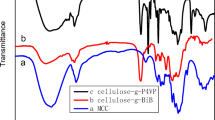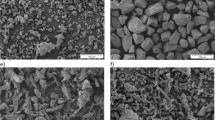Abstract
Poor drug solubility and consequently poor bioavailability are major impediments to new drug innovation, and they limit the performance of many existing drugs. In recent years amorphous solid dispersion (ASD) has emerged as one of the most effective approaches for enhancing drug solution concentration, and thereby bioavailability, including in many marketed drug formulations. Recently efforts have been under way in several laboratories to design new ASD polymers, rather than relying on polymers that are already in FDA-approved formulations, but were not designed as ASD polymers. We describe here the design and synthesis of a new class of polymers, alkyl cellulose ω-carboxyesters, for ASD formulation. We synthesize these polymers by reaction of cellulose alkyl ethers with monoprotected (benzyl ester), monofunctional long chain acid chlorides, followed by protecting group removal using mild hydrogenolysis to form the target alkyl cellulose ω-carboxyalkanoate. These new amphiphilic polymers have high glass transition temperatures (Tg), tunable carboxyl content for controlling release pH and drug-polymer interactions, and certain members of this new group of amphiphilic cellulose ether esters are shown to be successful at forming ASDs with the important model drug ritonavir. These ASDs efficiently release ritonavir at small intestine pH, creating the maximum attainable amorphous solubility (20 μg/mL), and maintaining it for a time period substantially greater than the normal residence time in the absorptive region of the stomach and small intestine. Members of this new class of alkyl cellulose ω-carboxyester amphiphiles show significant potential as ASD polymers for enhancing oral bioavailability of otherwise poorly soluble drugs.











Similar content being viewed by others
References
Albertsson AC, Lundmark S (1990) Melt polymerization of adipic anhydride (oxepane-2,7-dione). J Macromol Sci 27:397–412. doi:10.1080/00222339009349564
Al-Obaidi H, Buckton G (2009) Evaluation of griseofulvin binary and ternary solid dispersions with HPMCAS. AAPS PharmSciTech 10:1172–1177. doi:10.1208/s12249-009-9319-x
Arca HC (2016) Cellulose esters and cellulose ether esters for oral drug delivery systems. Dissertation, Virginia Tech
Babcock WC, Friesen DT, Lyon DK, Miller WK, Smithey DT (2005) Pharmaceutical compositions with enhanced performance. WO2005115330 A2
Babcock WC, Friesen DT, Lyon DK, Miller WK, Smithey DT (2013) Pharmaceutical compositions with enhanced performance. US Patent 8,617,604
Bittorf KJ, Katstra JP, Gaspar F (2014) Pharmaceutical compositions. US Patent 8,885,152
Casterlow SA (2012) Characterization and Pharmacokinetics of Rifampicin Laden Carboxymethylcellulose Acetate Butyrate Particles. Dissertation, Virginia Tech
Chow S-L, Wong D (2011) Controlled release hydrogel formulation. US Patent Application US 20110165236 A1
Dawsey TR, McCormick TLJ (1990) The lithium chloride/dimethylacetamide solvent for cellulose: a literature review. Macromol Sci C 30:405–440. doi:10.1080/07366579008050914
Erler U, Mischnick P, Stein A, Klemm D (1992) Determination of the substitution patterns of cellulose methyl ethers by HPLC and GLC-comparison of methods. Polym Bull 29:349–356. doi:10.1007/BF00944830
Fedors RF (1974) A method for estimating both the solubility parameters and molar volumes of liquids. Polym Eng Sci 14:147–154. doi:10.1002/pen.760140211
Heinze T, Liebert T (2001) Unconventional methods in cellulose functionalization. Prog Polym Sci 26:1689–1762. doi:10.1016/S0079-6700(01)00022-3
Ilevbare GA, Liu H, Edgar KJ, Taylor LS (2012a) Understanding Polymer Properties Important for Crystal Growth Inhibition – Impact of Chemically Diverse Polymers on Solution Crystal Growth of Ritonavir. Cryst Growth Des 12:3133–3143. doi:10.1021/cg300325p
Ilevbare GA, Liu H, Edgar KJ, Taylor LS (2012b) Inhibition of solution crystal growth of ritonavir by cellulose polymers—factors influencing polymer effectiveness. CrystEngComm 14:6503–6514. doi:10.1039/C2CE25515D
Ilevbare GA, Liu H, Edgar KJ, Taylor LS (2013) Maintaining supersaturation in aqueous drug solutions: impact of different polymers on induction times. Cryst Growth Des 13:740–751. doi:10.1021/cg301447d
Kar N, Liu H, Edgar KJ (2011) Synthesis of cellulose adipate derivatives. Biomacromolecules 12:1106–1115. doi:10.1021/bm101448f
Kawabata Y, Wada K, Nakatani M, Yamada S, Onoue S (2011) Formulation design for poorly water-soluble drugs based on biopharmaceutics classification system: basic approaches and practical applications. Int J Pharm 420:1–10. doi:10.1016/j.ijpharm.2011.08.032
Khougaz K, Clas SD (2000) Crystallization inhibition in solid dispersions of MK-0591 and poly(vinylpyrrolidone) polymers. J Pharm Sci 89:1325–1334. doi:10.1002/1520-6017(200010)89:10<1325:AID-JPS10>3.0.CO;2-5
Krayz GT, Averbuch M, Zelkind I, Gitis L (2009) Compositions comprising lipophilic active compounds and method for their preparation. US Patent 9,254,268
Lauer ME, Grassmann O, Siam M, Tardio J, Jacob L, Page S, Kindt JH, Engel A, Alsenz J (2011) Atomic force microscopy-based screening of drug-excipient miscibility and stability of solid dispersions. Pharm Res 28:572–584. doi:10.1007/s11095-010-0306-4
Li B, Konecke S, Wegiel LA, Taylor LS, Edgar KJ (2013a) Both solubility and chemical stability of curcumin are enhanced by solid dispersion in cellulose derivative matrices. Carbohydr Polym 98:1108–1116. doi:10.1016/j.carbpol.2013.07.017
Li B, Harich K, Wegiel L, Taylor LS, Edgar KJ (2013b) Stability and solubility enhancement of ellagic acid in cellulose ester solid dispersions. Carbohydr Polym 92:1443–1450. doi:10.1016/j.carbpol.2012.10.051
Li B, Konecke S, Harich K, Weigel L, Taylor LS, Edgar KJ (2013c) Solid dispersion of quercetin in cellulose derivative matrices influences both solubility and stability. Carbohy Carbohydr Polym 92:2033–2040. doi:10.1016/j.carbpol.2012.11.073
Liu H, Kar N, Edgar KJ (2012) Direct synthesis of cellulose adipate derivatives using adipic anhydride. Cellulose 19:1279–1293. doi:10.1007/s10570-012-9724-2
Liu H, Ilevbare GA, Cherniawski BP, Ritchie ET, Taylor LS, Edgar KJ (2014) Synthesis and structure–property evaluation of cellulose ω-carboxyesters for amorphous solid dispersions. Carbohydr Polym 100:116–125. doi:10.1016/j.carbpol.2012.11.049
Malm CJ, Emerson J, Hiait GD (1951) Cellulose acetate phthalate as an enteric coating material. J Am Pharm Assoc (Scientific ed) 40:520–525. doi:10.1002/jps.3030401014
Malm CJ, Laird BC, Smith GD, Tanghe LJ (1954) Determination of total and primary hydroxyl in cellulose esters by ultraviolet absorption methods. Anal Chem 26:188–190. doi:10.1021/ac60085a029
Miller JM, Beig A, Carr RA, Spence JK, Dahan A (2012) A win-win solution in oral delivery of lipophilic drugs: supersaturation via amorphous solid dispersions increases apparent solubility without sacrifice of intestinal membrane permeability. Mol Pharm 9:2009–2016. doi:10.1021/mp300104s
Nasatto P, Pignon F, Silveira J, Duarte MER, Noseda MD, Rinaudo M (2015) Methylcellulose, a cellulose derivative with original physical properties and extended applications. Polymers 7:777–803. doi:10.3390/polym7050777
Pereira JM, Mejia-Ariza R, Ilevbare GA, McGettigan HE, Sriranganathan N, Taylor LS, Davis RM, Edgar KJ (2013) Interplay of degradation, dissolution and stabilization of clarithromycin and its amorphous solid dispersions. Mol Pharm 10:4640–4653. doi:10.1021/mp400441d
Posey-Dowty JD, Watterson TL, Wilson AK, Edgar KJ, Shelton MC, Lingerfelt LR (2007) Zero-order release formulations using a novel cellulose ester. Cellulose 14:73–83. doi:10.1007/s10570-006-9079-7
Qian F, Huang J, Hussain MA (2010) Drug-polymer solubility and miscibility: stability consideration and practical challenges in amorphous solid dispersion development. J Pharm Sci 99:2941–2947. doi:10.1002/jps.22074
Rumondor AC, Stanford LA, Taylor LS (2009) Effects of polymer type and storage relative humidity on the kinetics of felodipine crystallization from amorphous solid dispersions. Pharm Res 26:2599–2606. doi:10.1007/s11095-009-9974-3
Sarode AL, Sandhu H, Shah N, Malick W, Zia H (2013) Hot melt extrusion (HME) for amorphous solid dispersions: predictive tools for processing and impact of drug-polymer interactions on supersaturation. Eur J Pharm Sci 48:371–384. doi:10.1016/j.ejps.2012.12.012
Shelton MC, Posey-Dowty JD, Lingerfelt L, Kirk SK, Klein S, Edgar KJ (2009) Enhanced dissolution of poorly soluble drugs from solid dispersions in carboxymethylcellulose acetate butyrate matrices. In ACS Symposium Series, vol 1017. Oxford University Press, Oxford, pp. 93–113
Tanno F, Nishiyama Y, Kokubo H, Obara S (2004) Evaluation of hypromellose acetate succinate (HPMCAS) as a carrier in solid dispersions. Drug Dev Ind Pharm 30:9–17. doi:10.1081/DDC-120027506
Terbojevich M, Cosani A, Camilot M, Focher B (1995) Solution Studies of Cellulose Tricarbanilates Obtained in Homogeneous Phase. J Appl Polym Sci 55:1663–1671. doi:10.1002/app.1995.070551206
Van den Mooter G (2012) The use of amorphous solid dispersions: a formulation strategy to overcome poor solubility and dissolution rate. Drug Discov Today Technol 9:e71–e174. doi:10.1016/j.ddtec.2011.10.002
Vasconcelos T, Sarmento B, Costa P (2007) Solid dispersions as strategy to improve oral bioavailability of poor water soluble drugs. Drug Discov Today 12:1068–1075. doi:10.1016/j.drudis.2007.09.005
Wegiel LA, Zhao Y, Mauer LJ, Edgar KJ, Taylor LS (2014) Curcumin amorphous solid dispersions: the influence of intra and intermolecular bonding on physical stability. Pharm Dev Technol 19:976–986. doi:10.3109/10837450.2013.846374
Zheng X, Gandour RD, Edgar KJ (2013) TBAF-catalyzed deacylation of cellulose esters: reaction scope and influence of reaction parameters. Carbohydr Polym 98:692–698. doi:10.1016/j.carbpol.2013.06.010
Zhou D, Zhang GGZ, Law D, Grant DJW, Schmitt EA (2002) Physical stability of amorphous pharmaceuticals: importance of configurational thermodynamic quantities and molecular mobility. J Pharm Sci 91:1863–1872. doi:10.1002/jps.10169
Acknowledgements
We thank Ashland Inc. for their kind donation of EC used in this work. We thank the NSF for funding this work through award 1312157-IIP. We are grateful to the Macromolecules and Interfaces Institute (MII), and the Institute for Critical Technologies and Applied Science (ICTAS) at Virginia Tech for their financial, facility, and educational support. We thank Dr. Ann Norris for assistance with XRD experiments, and Mr. Scott Radzinski and Mr. Kevin Drummey for assistance with SEC experiments.
Author information
Authors and Affiliations
Corresponding author
Electronic supplementary material
Below is the link to the electronic supplementary material.
Rights and permissions
About this article
Cite this article
Arca, H.C., Mosquera-Giraldo, L.I., Taylor, L.S. et al. Synthesis and characterization of alkyl cellulose ω-carboxyesters for amorphous solid dispersion. Cellulose 24, 609–625 (2017). https://doi.org/10.1007/s10570-016-1156-y
Received:
Accepted:
Published:
Issue Date:
DOI: https://doi.org/10.1007/s10570-016-1156-y




